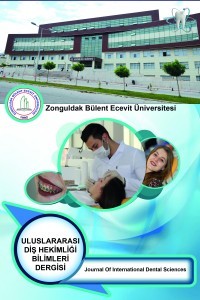Atatürk Üniversitesi Dishekimliği Fakültesi Birinci Ve Beşinci Sınıf Öğrencilerinin Ağız Ve Diş Sağlığı Konusundaki Bilgi Düzeylerinin Karşılaştırılması
Bu anket çalışmasında diş hekimliği fakültesi 1. ve 5. Sınıf öğrencilerinin ağız ve diş sağlığı ile ilgili bilgi düzeylerinin belirlenerek cinsiyet ve sınıfa göre karşılaştırılması amaçlanmıştır. Atatürk Üniversitesi Diş Hekimliği Fakültesi 1. ve 5. sınıfta okuyan, rastgele seçilen kız ve erkek öğrenciler ankete dahil edildi. (n=80) Öğrencilere ağız ve diş sağlığı tutum davranış ve bilgi düzeylerini belirlemek için çoktan seçmeli 25 sorudan oluşan anket uygulandı. Elde edilen veriler Pearson ki-kare testi ile istatistiksel olarak değerlendirildi. Çalışmada yer alan 160 öğrencinin 98’i kız 62’si erkek öğrencidir. Kız öğrencilerin diş fırçalama ve diş hekimine gitme sıklığının erkek öğrencilerden daha fazla olduğu belirlenmiştir. İstatistiksel sonuçlara göre 5. Sınıf öğrencilerinin 1. Sınıf öğrencilere göre; İdeal oranda diş macunu kullandığı, arayüz temizliğine daha fazla önem verdiği, daha sık ve düzenli diş hekimi kontrolüne gittiği, diş fırçalamayı doğru teknik ile daha etkin yaptıkları ve koruyucu önlemler hakkında daha çok bilgiye sahip oldukları görülmüştür (p<0.05).Bununla birlikte beşinci sınıf öğrencilerinin daha fazla sigara kullandıkları belirlenmiştir.(p<0.05) Diş hekimliği eğitim ve öğrenim süreci 1. Sınıftan 5. Sınıfa gelinceye kadar ağız ve diş sağlığı bilincini ve bilgi düzeyini artırmaktadır.
Anahtar Kelimeler:
Ağız ve Diş Sağlığı, Bilgi Düzeyi, Diş Hekimliği Öğrencileri
Comprasion Of Knowledge Levels On Oral And Dental Health Of The First And Fıve Years Of Graudate Students Ataturk Unıversity Faculty
In this questionnaire study, it was aimed to determine the level of knowledge about oral and dental health of 1st and 5th year students in the faculty of dentistry and compare them according to sex and class. Female and male students randomly selected from Atatürk University Dentistry Faculty 1st and 5th grade were included in the questionnaire. (n = 80) A questionnaire consisting of 25 multiple-choice questions was administered to the students to determine their oral and dental health attitude behavior and knowledge levels. The obtained data were evaluated statistically by Pearson chi-square test.Of the 160 students in the study, 98 are girls and 62 are boys. It was determined that the frequency of female students brushing teeth and going to dentist was higher than male students. According to the statistical results, 5th grade students according to the first grade students think that they use ideal toothpaste, more importance to interface cleanliness, more frequent and regular dental control, more effective toothbrushing with the right technique and more information about preventive measures (p <0.05). However, fifth grade students were found to use more cigarettes (p <0.05) Dental health education and training process increases awareness of oral and dental health and knowledge level from first to fifth year.
Keywords:
: Oral and dental health, Dentsitry student, knowledge level,
___
- 1. Petersen PE. World Health Organization global policy for improvement of oral health‐World Health Assembly 2007. Int Dent J 2008;58(3):115-21.
- 2. Ramirez JH, Arce R, Contreras A. Why must physicians know about oral diseases? Teach Learn Med 2010;22(2):148-55.
- 3. ÇALIŞKAN D, Yaşar F, Tunçbilek A. AÜ TF 9-10 Sömestr Öğrencilerinin Ağız ve Diş Sağlığı Konusunda Bilgi Düzeyleri. Ankara Üniversitesi Tıp Fakültesi Mecmuası.55(02).
- 4. Linden GJ LA, Scannapieco FA. . Periodontal systemic associations: Review of the evidence. J Clin Periodontol 2013; S8 19.:40.
- 5. Jin L, Lamster I, Greenspan J, Pitts N, Scully C, Warnakulasuriya S. Global burden of oral diseases: emerging concepts, management and interplay with systemic health. Oral Dis 2016;22(7):609-19.
- 6. Park JB, Han K, Park YG, Ko Y. Association between socioeconomic status and oral health behaviors: The 2008-2010 Korea national health and nutrition examination survey. Exp Ther Med.2016;12(4):2657-64.
- 7. Macintyre S. Understanding the social patterning of health: the role of the social sciences. Am. J. Public Health.1994;16(1):53-9.
- 8. Marmot MG, Stansfeld S, Patel C, North F, Head J, White I, et al. Health inequalities among British civil servants: the Whitehall II study. The Lancet. 1991;337(8754):1387-93.
- 9. Rimondini L, Zolfanelli B, Bernardi F, Bez C. Self‐preventive oral behavior in an Italian university student population. J. Clin. Periodontol.2001;28(3):207-11.
- 10. ŞB Ö. Topluma dayalı tıp eğitimi. Toplum Hekimliği Bülteni. 2007;26:1-6.
- 11. Ahlberg J, Rantala M, Savolainen A, Suvinen T, Nissinen M, Sarna S, et al. Reported bruxism and stress experience. Community Dent Oral Epidemiol. 2002;30(6):405-8.
- 12. Dahlin M, Joneborg N, Runeson B. Stress and depression among medical students: A cross‐sectional study. Med Educ 2005;39(6):594-604.
- 13. Cavallo P, Carpinelli L, Savarese G. Perceived stress and bruxism in university students. BMC Res Notes 2016;9(1):514.
- 14. Çebi S DB, Demiröz T. . Diş hekimliği eğitiminin diş sağlığına etkisi. . Hacettepe Diş Hek Fak Derg 1978;2:211-22.
- 15. Yılmaz A, Ceylan G, Yanıkoğlu N, Akgül M. Atatürk Üniversitesi Diş Hekimliği Fakültesi Öğrencilerinde Ağız Sağlığı Çalışması Ve Diş Hekimliği Eğitiminin Ağız Sağlığına Etkinin Araştırılması. Atatürk Üniv. Diş Hek Fak Derg. 1997;7(1):36-9.
- 16. Lang N, Gumming B, Löe H. Oral hygiene and gingival health in Danish dental students and faculty. Community Dent Oral Epidemiol 1977;5(5):237-42.
- 17. Halboub ES, Al-Maweri SA, Al-Jamaei AA, Al-Wesabi MA, Shamala A, Al-Kamel A, et al. Self-reported oral health attitudes and behavior of dental and medical students, Yemen. Glob J Health Sci. 2016;8(10):56676.
- 18. Kumar H, Behura SS, Ramachandra S, Nishat R, Dash KC, Mohiddin G. Oral health knowledge, attitude, and practices among dental and medical students in Eastern India–A comparative study. J Int Soc Prev Community Dent 2017;7(1):58.
- ISSN: 2149-8628
- Yayın Aralığı: Yılda 3 Sayı
- Yayıncı: Zonguldak Bülent Ecevit Üniversitesi
Sayıdaki Diğer Makaleler
Seyit Bilal ÖZDEMİR, Büşra ÖZDEMİR, Nurcan ÖZAKAR İLDAY
İmmatür Sürekli Dişlerin Etkilendiği Komplike Bir Travma Olgusu
Deniz Sıla ÖZDEMİR, Halenur ALTAN
Periferal Dev Hücreli Granülom: Olgu Sunumu
Hüseyin GÜLCAN, Mustafa Cenk DURMUŞLAR, Evşen ERTEM
Kuron Harabiyeti Olan Kanal Tedavili Dişlerde Endokuron Uygulamaları: Derleme
Cam Karbomerlerin Polimerizasyonundaki Sıcaklık Değişimlerinin Termografik Ölçümü
Mustafa DÜZYOL, Zeynep Merve ÖZDEMİR, Sevim ATILAN YAVUZ, Esra DÜZYOL
